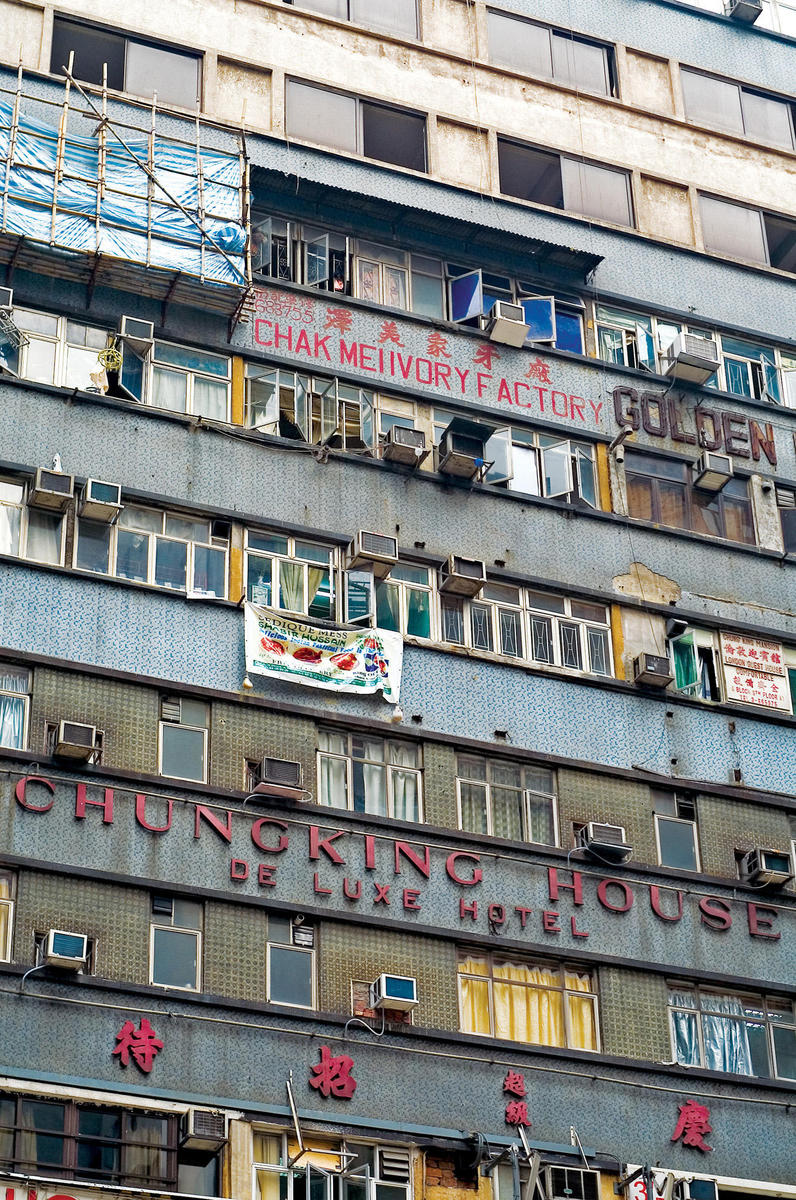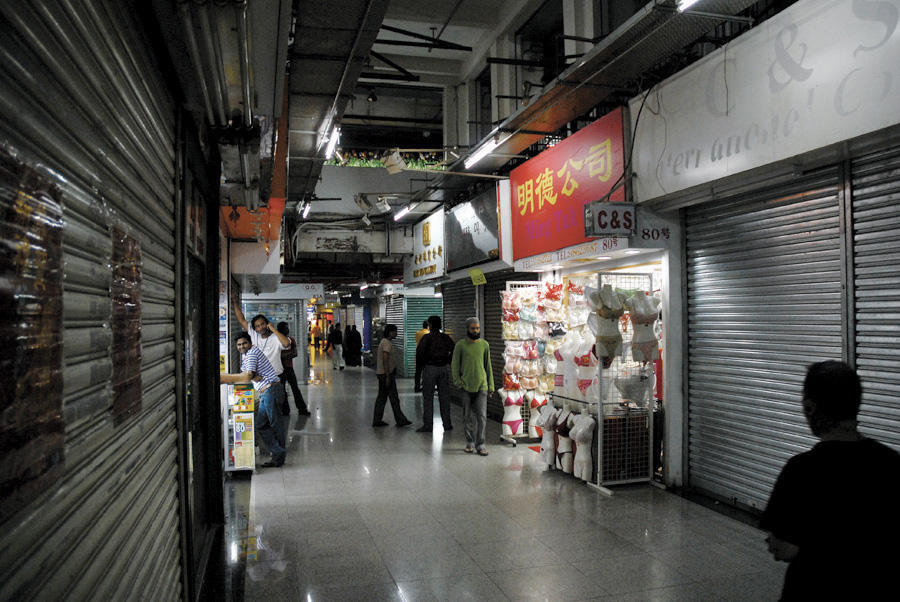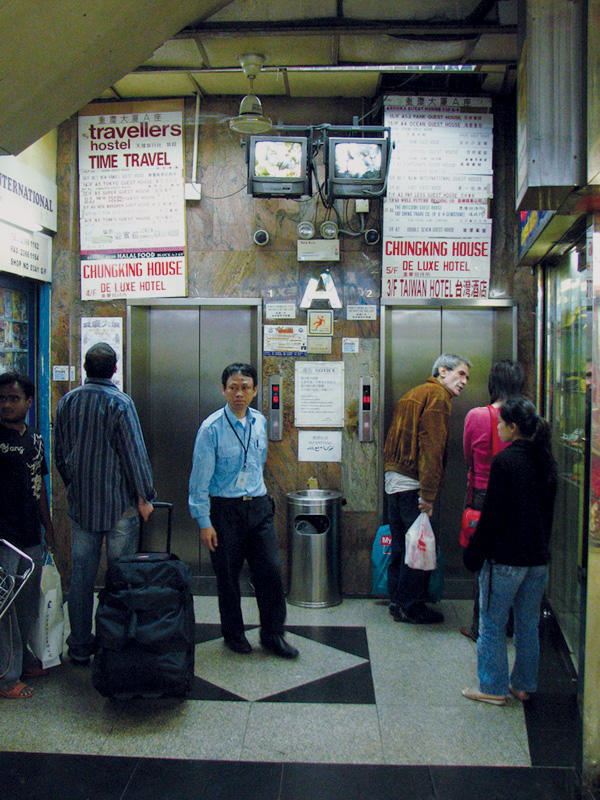
In many ways, Chungking Mansions appears to be a system on autopilot, a sort of urban artificial intelligence. It’s also an illustration of ground-level globalization (it’s estimated that at least twenty percent of all mobile phones in usage in Africa have passed through #36-44 Nathan Road at one point) and a condensed model of world catastrophe.
Up in my room, things are quiet. Though there’s a softly whirring fan and water dripping in the airshaft, the ancient, wall-mounted television doesn’t rise above a murmur. Down in the street, on the other hand, the world runs at full volume. On a typical night, the sidewalk of Hong Kong’s Chungking Mansions is roaring. In contrast to the sedate Peninsula Hotel just across Nathan Road (the colonial grande dame of hotels, where white-gloved waiters serve tea), there is no marble reception desk here — there is only pavement.
On this night, eight young Indian guesthouse touts form a gauntlet, each trying aggressively to persuade a dazed Australian backpacker and a broad Nigerian businessman that his establishment is top of the line. Some of the men are doing double-duty, simultaneously pushing restaurants or tailor-shops, fake watches or hashish. The Nigerian waves them away: he has been here before and knows exactly where he’s going.
Heading to the elevators, he passes a gaggle of women in bright blue salwar kameez, changing rupees at one of the many exchange booths that line the entrance. Young Chinese women with frizzy hair sit behind the bulletproof glass with sour expressions. He zigzags toward the bank of elevators at Block B and joins the queue. The dazed Australian ends up there, too, with a guesthouse worker practically clinging to his backpack to make sure his “sale” won’t get stolen away. There’s a lanky Somali woman with a swaddled baby, and a young boy laden with takeout containers from a restaurant.
The elevator rises and stops at the seventh and fifteenth floors; the Australian and the Nigerian are staying in different guesthouses. Doors are opened. Fans and televisions are switched on and off. Rates are bargained down. Keys are handed over. And, because no traveler wants to sit in a bed-sized room watching the fuzzy Nepalese news on mute, guests lock their bags in their rooms and head back to the mainframe.

This massive complex of five blocks (A–E) and seventeen stories was completed in 1961, originally intended as luxury flats for Hong Kong’s elite. But when the Mansions was opened, a different brand of clientele moved in. The first tenants were hardscrabble immigrants from the mainland, who in turn sold units to members of Hong Kong’s resident Indian community. As a major transportation hub (Victoria Harbor, the Kowloon-Canton Railway, old Kai Tak Airport), Kowloon had long been a natural magnet for travelers. The Mansions gained a seedier reputation in the 1960s and 70s, due in no small part to hordes of American servicemen on shore leave.
Decades later, Chungking isn’t just a hotel space; its nearly 1,000 guestrooms have lent shape and purpose to the structure as a whole. Although the rooms belong to roughly ninety distinct guesthouses, these distinctions begin to melt as the greater design of the Mansions reveals itself.
The rooms are almost all the same — large enough for a bed (a rock-hard twin kitted out in faded sheets bearing the visage of Mickey Mouse), a single square-foot window, and, if one is willing to upgrade to what is termed “ensuite,” a telephone booth-sized bathroom. Some rooms are a bit more “business motel” (double beds, pastels) in nature, others more “flop-house” (six Indian restaurant workers sharing the floor of a forty-square-foot room). But since few of the guesthouses are anything more than a blank hallway punctuated by five to ten doors, there’s little space for the expression of individual hotel identity. Chungking Mansions is a meta-hotel.
Within the main building, guests may choose from several dozen restaurants or order room service (all the restaurants deliver). For entertainment, cheap DVDs and DVD players, both bootleg, abound. Internet cafes and international calling-card shops (“$1 per minute to Ghana”) serve as a kind of business center, and restaurants that stay open late double as hotel bars. (There’s also an all-night 7-Eleven around the corner, which is the prime place to pick up female company for the night.)
Most of the waiters, cooks, touts, and men pushing boxes through the hallways, as well as the women who “work” the place (primarily Indian, dressed in bright saris and far too much makeup), are travelers themselves. This is another remarkable feature of Chungking Mansions: the guests are, in essence, running the hotel. Those who own property and shops in the building have proper immigration papers or Hong Kong residency, as do the managers they hire. But the managers then rely on temporary, illegal labor to run their businesses. Because of tight visa regulations, many of these temporary workers must return home fairly frequently or go on exit/reentry runs to the mainland or Macau. Some may continue this cycle, coming and going, for years.

But while illegal labor is rampant, and prostitutes and drugs are never in short supply, Chungking’s current illicit activities pale in comparison to those of the past. In a city with relatively few ethnic minorities and very little poverty, Chungking has been more or less the only ghetto in Hong Kong. The 1980s were a golden age of gonzo criminality, and the Mansions became a haven for heroin and hashish smugglers, arms dealers, and arsonists. In one three-year period, twenty-nine fires were reported, including one in which a Danish tourist died jumping out of a guesthouse window. And once, a long-term C-Block resident, a man from New Zealand, was discovered to have turned his room into a DIY bomb-making workshop.
In many ways, Chungking Mansions appears to be a system on autopilot, a sort of urban artificial intelligence. It’s also an illustration of ground-level globalization (it’s estimated that at least twenty percent of all mobile phones in usage in Africa have passed through #36–44 Nathan Road at one point) and a condensed model of world catastrophe. There are currently 2,500 refugees and asylum-seekers in Hong Kong, most of whom have stayed in Chungking Mansions or used services there.
Ironically, it seems that Chungking Mansions may outlast most other Hong Kong landmarks, despite its almost ethereal transience. Because the colossal structure is owned by so many individual property owners, a developer wishing to buy them all out would need about 20 billion Hong Kong dollars (roughly 3 billion USD) — far more than any new development could possibly justify. Perhaps, with the Peninsula Hotel down the street evoking fading colonial grandeur, Chungking Mansions is a window (one square foot, covered with a Snoopy drape, facing an air-shaft) onto the future.